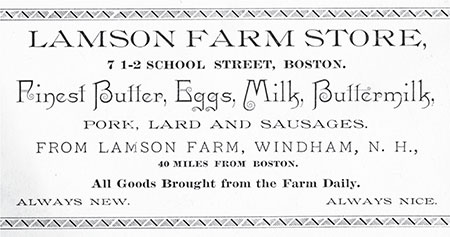
An 1890s trade card advertising Lamson’s Farm Store in Boston, Massachusetts. Author’s collection .
13
LAMSON’S FARM
William Stickney Lamson’s dairy farm in Windham is but one example of the typical dairy farm in Windham at the turn of the twentieth century. Lamson was born in Newburyport, Massachusetts, in 1845. As a young man, he worked as a commercial artist and later served in the military for a brief period of time. Lamson married Mary-Anna Campbell of Windham sometime in the later years of the 1860s, and the couple had two sons, William-Abbot and Frank-Fitz. However, in the 1870s, Lamson saw the need for improving a new technology, the cash carrier; he filed for a patent for his improvements in 1879. The Lamson Cash Carrier Corporation was formed in 1882, following a patent being granted for a greatly improved cash railway system. The ancestor of the modern pneumatic cash delivery systems one may see at the drive-up window at a modern-day bank, this system was composed of sloping metal rails, on which a small container could slide to its destination. Many of the early models of this system were noisy, and the cash container was prone to falling off the rails. Although the cash railway promised a new, efficient way to transfer cash within a place of business, it would be years before it was perfected by William Stickney Lamson.
Lamson’s patent describes several significant improvements that the inventor had made to the system, one of which was reducing the noise created as the container made its way around the track. One can imagine how irritated a shop clerk might get after spending all day listening to the sound of the metal track. Also, the newly patented system greatly reduced the likelihood that the container might slip off the rail after picking up some speed or making a particularly sharp turn. Other new features included an easier way to open and close the cash container, as well as making improvements with placing the container on and removing the container from the track.
When Lamson began to manufacture his product, his company quickly became successful, making him a wealthy man. By 1885, his company had installed nearly six hundred systems in stores across the nation. As the company grew, it bought out smaller rivals and eventually became the Lamson Company. Wishing to escape the city in the summers, Lamson purchased a farm in Windham in September 1892 for several thousand dollars. However, Lamson soon saw an opportunity to operate the farm as a business. Unlike the other farmers of Windham, Lamson had planned to open a farm store in Boston in order to sell the meat and dairy products produced at his farm. A period trade card advertises the “finest butter, eggs, milk, buttermilk, pork, lard, and sausages,” all of which came from his Windham farm, located about forty miles from Boston. Everything was brought to the Boston store daily by train, ensuring only the freshest products were being sold to the customers in the city.
One of the workers at his farm was Ernest Hammond, who was born near the summit of Bauneg-Beg Mountain in North Berwick, Maine, in 1860. As a teenager, he gained experienced selling gardening and farming equipment with his father and brother. Within the span of several years, he saved both his father and younger brother from drowning on two separate occasions, earning him a reputation of being a courageous young man. When he was twenty-four years old, he decided to leave Maine to work on the flourishing farm of William Lamson. Lamson saw promise in the young man and offered him a position in the fruit department. However, Hammond was soon promoted to the manager of the Lamson Farm Store in Boston, as well as superintendent of the Windham farm.

An 1890s trade card advertising Lamson’s Farm Store in Boston, Massachusetts. Author’s collection .
On one of Hammond’s regular business trips to Lowell, he was walking along the street when he saw a horse that had broken away from its hitching post heading in his direction. Living up to his reputation for being courageous, Hammond ran toward the horse and was able to wrap his arms around its head. Hammond was carried by the horse for some distance before his hold finally weakened and he was thrown into the street. The incident left him unconscious, and he was picked up and carried to the nearby Lowell Hospital. His condition was critical, with his face mangled, a bone broken and a severe injury to the back of his neck that almost cost him his life. Although he recovered from the broken bone and facial injuries, Hammond was plagued by neck problems for the rest of his life. His injuries naturally left him unable to continue his work for Lamson, and he left for Rhode Island soon after.
The creamery at Windham did not remain open long, closing after just a few years of operation. The farm was purchased by Traders & Mechanics Insurance Company; in 1896, the property was transferred to the National Angora Goat Raising Company. Although the property was no longer used for producing dairy, the dairy industry remained important in Windham until the 1950s. Refrigerated train cars, and later motor trucks, allowed local farmers to sell their milk and cream to larger operations, including H.P. Hood. However, eventually the large dairy companies began to purchase from only large, industrial-scale farms, and there was little business for the farmers of Windham.